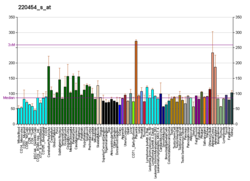| SEMA6A |
|---|
|
| Available structures |
|---|
| PDB | Ortholog search: PDBe RCSB |
|---|
| List of PDB id codes |
|---|
3AFC, 3AL8, 3OKW, 3OKY |
|
|
| Identifiers |
|---|
| Aliases | SEMA6A, HT018, SEMA, SEMA6A1, SEMAQ, VIA, semaphorin 6A |
|---|
| External IDs | OMIM: 605885; MGI: 1203727; HomoloGene: 32426; GeneCards: SEMA6A; OMA:SEMA6A - orthologs |
|---|
| Gene location (Human) |
|---|
 | | Chr. | Chromosome 5 (human)[1] |
|---|
| | Band | 5q23.1 | Start | 116,443,555 bp[1] |
|---|
| End | 116,574,823 bp[1] |
|---|
|
| Gene location (Mouse) |
|---|
 | | Chr. | Chromosome 18 (mouse)[2] |
|---|
| | Band | 18|18 C | Start | 47,368,665 bp[2] |
|---|
| End | 47,501,937 bp[2] |
|---|
|
| RNA expression pattern |
|---|
| Bgee | | Human | Mouse (ortholog) |
|---|
| Top expressed in | - inferior ganglion of vagus nerve
- external globus pallidus
- subthalamic nucleus
- corpus callosum
- jejunal mucosa
- lateral nuclear group of thalamus
- pars reticulata
- ventral tegmental area
- superior vestibular nucleus
- pons
|
| | Top expressed in | - tail of embryo
- genital tubercle
- lumbar subsegment of spinal cord
- yolk sac
- Dermatocranium
- membranous bone
- epiblast
- mandible
- cartilage of the septum
- medial geniculate nucleus
|
| | More reference expression data |
|
|---|
| BioGPS |  | | More reference expression data |
|
|---|
|
| Gene ontology |
|---|
| Molecular function | - protein binding
- semaphorin receptor binding
- chemorepellent activity
| | Cellular component | - integral component of membrane
- axon
- plasma membrane
- membrane
- integral component of plasma membrane
- extracellular space
| | Biological process | - animal organ morphogenesis
- multicellular organism development
- cell surface receptor signaling pathway
- cell differentiation
- cytoskeleton organization
- nervous system development
- apoptotic process
- axon guidance
- positive regulation of neuron migration
- negative regulation of sprouting angiogenesis
- negative regulation of angiogenesis
- negative regulation of cell adhesion involved in sprouting angiogenesis
- cellular response to vascular endothelial growth factor stimulus
- negative regulation of ERK1 and ERK2 cascade
- negative regulation of vascular endothelial growth factor signaling pathway
- neural crest cell migration
- positive regulation of cell migration
- negative regulation of axon extension involved in axon guidance
- negative chemotaxis
- semaphorin-plexin signaling pathway
| | Sources:Amigo / QuickGO |
|
| Orthologs |
|---|
| Species | Human | Mouse |
|---|
| Entrez | | |
|---|
| Ensembl | | |
|---|
| UniProt | | |
|---|
| RefSeq (mRNA) | |
|---|
NM_001300780
NM_020681
NM_020796 |
| |
|---|
| RefSeq (protein) | | |
|---|
| Location (UCSC) | Chr 5: 116.44 – 116.57 Mb | Chr 18: 47.37 – 47.5 Mb |
|---|
| PubMed search | [3] | [4] |
|---|
|
| Wikidata |
| View/Edit Human | View/Edit Mouse |
|



















